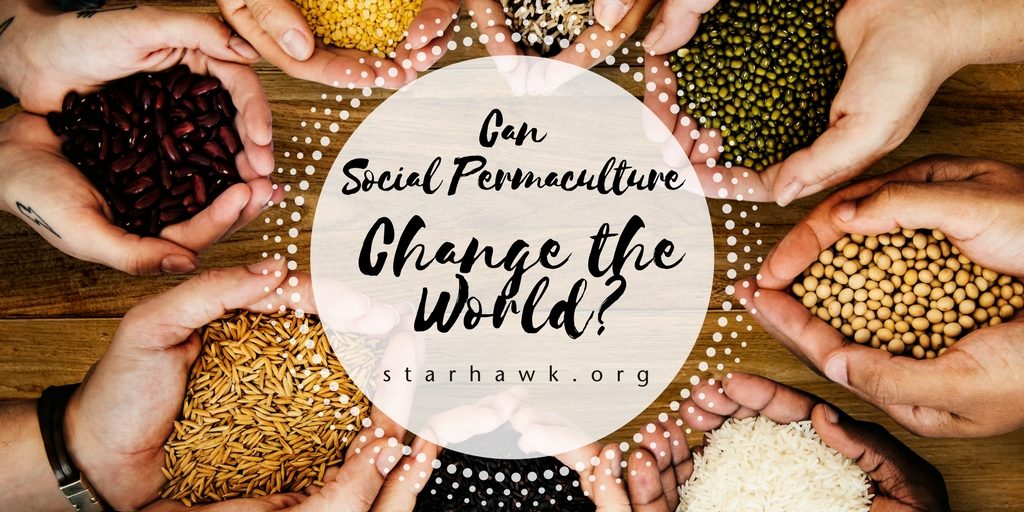Can Social Permaculture Change the World?

“Never doubt that a small
group of thoughtful, committed citizens can change the world; indeed,
it’s the only thing that ever has.”
-Margaret Mead
Small Groups Can Indeed Change the World—
—but to do so, they must work together effectively and nourish their relationships. Sadly,
there’s a pattern that repeats again and again: a group of people come
together excited to do work to change the world or create something that
inspires them all. In the beginning, all goes well…
…then conflicts arise.
Sometimes deep divisions and power struggles erupt. Other times, people just quietly fade away. A brilliant idea, an exciting project, a community in which people have invested emotionally and financially withers and dies.
For decades, I’ve worked in small
groups, from permaculture guilds to activist organizations to group
houses, and experienced plenty of conflicts and breakdowns, as well as
wonderful moments of joyful collaboration. I know the negative patterns can be changed.
If we identify the conditions that allow
groups to thrive and flourish, we can consciously design them into our
group structures. We can commit to learning and practicing better communication skills and using conflict resolution tools. We
can seed our groups in healthy soil, and create movements that are
truly inclusive and welcoming to all of us, in the full complexity of
who we are. And when we do, all of our important work becomes more effective.

What is Social Permaculture?
“Social Permaculture” is a term that has
become more prevalent in the permaculture world to describe all the
aspects of people-care and group dynamics that go beyond the garden and
the food forest.
But perhaps I should take a step back and
say that “permaculture” is a global movement based on an approach to
ecological design with an ethical framework, that takes nature as our
model. By understanding the
principles of how nature works, we can create systems—whether for food
growing, shelter, or social projects—that meet our human needs while
regenerating the environment around us.
Permaculture began with an approach to
agriculture that draws on much indigenous wisdom and traditional
practices, but puts them together with systems theory and agro-ecology. However,
as it has expanded into a worldwide movement of practitioners and
teachers, it has grown to encompass the idea of permanent culture.

Culture is inherently social—it encompasses all the ways we connect, communicate, co-create, and clash. The
dominant culture is toxic in so many ways, from underlying structures
of oppression such as patriarchy and white supremacy, to its focus on
competition and individualism over community.
But can we actually apply principles of
design to changing these structures, both in the social landscape and in
the ways we have internalized them? Do the patterns and principles we find in nature have guidance for us in creating social change and building new institutions? 

Social Permaculture as a Solution
These are the questions that social
permaculture asks, and to address them we draw from many fields, from
psychology to sociology to theories of group dynamics and organizational
structure. A social permaculture course
might range from exploring how we connect across the barriers of
diversity and historical oppression, to how we resolve conflicts in
groups, to how we can structure organizations to encourage creativity
and collaboration. It is useful for anyone who works in groups: permaculture
guilds, activist groups, spiritual groups, co-housing communities,
community organizers, friendship groups, even personal relationships.
Our social permaculture courses are interactive, focused on learning skills and tools and practicing them. We use exercises, games, and projects to bring out patterns of communication, and provide support for self-reflection. We
address the larger cultural patterns of racism, sexism, heterosexism,
ableism, class divisions and more, in a spirit that asks us to redesign
patterns of relationships so that we can connect, share, and celebrate
more deeply.
And we ground our work in a deep, spiritual connection to nature and one another.
Of all the work and teaching I do, social permaculture is perhaps the most vital, because it offers tools to make all of our work more successful and joyful. In these times of chaos and crisis, we need effective groups that can make change. And we need places of support and nurturance that can feed us as we work for a world of justice and resilience.
Aucun commentaire:
Enregistrer un commentaire